Lincoln-Douglas Debate An Examination of Values

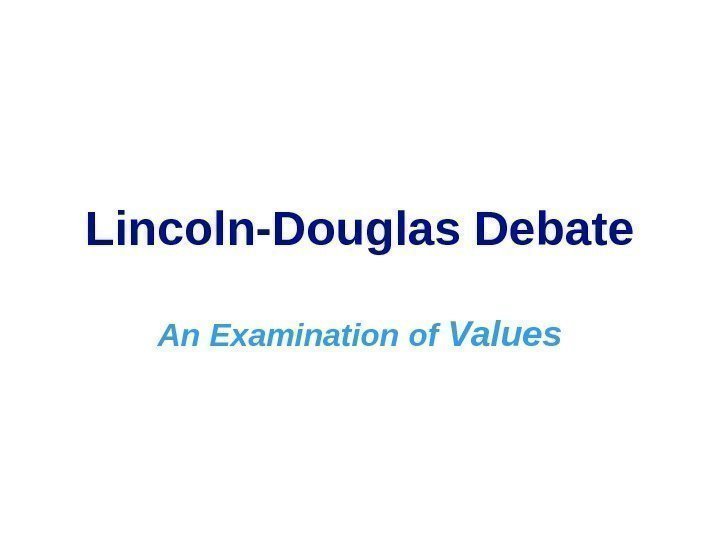
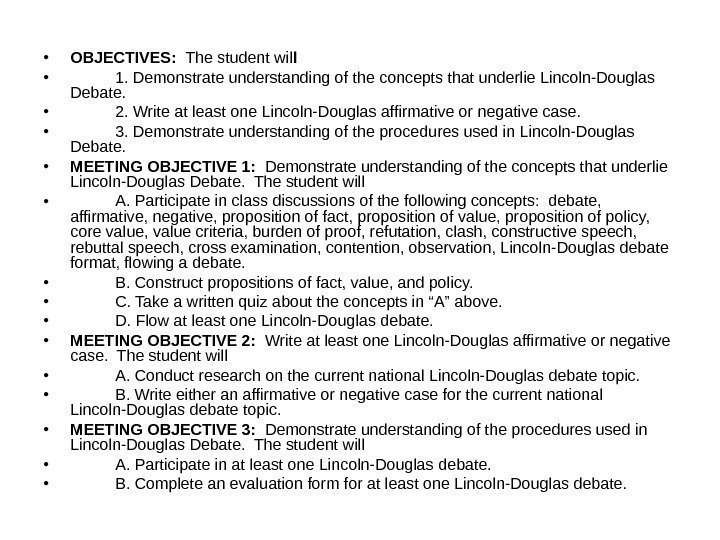
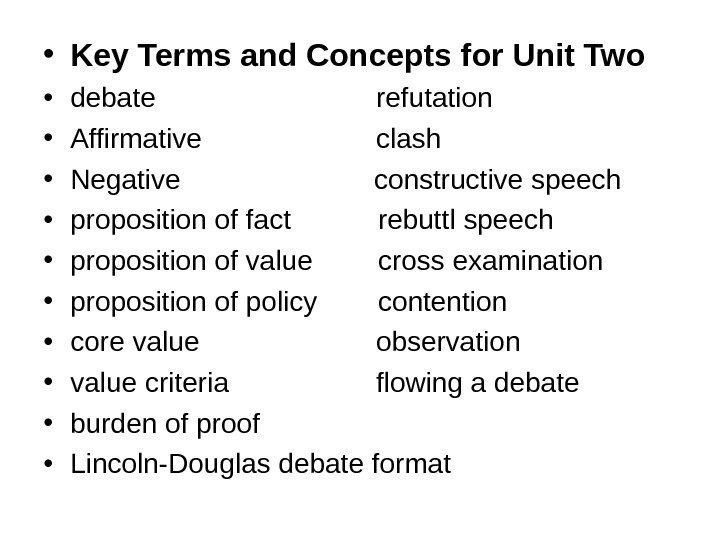
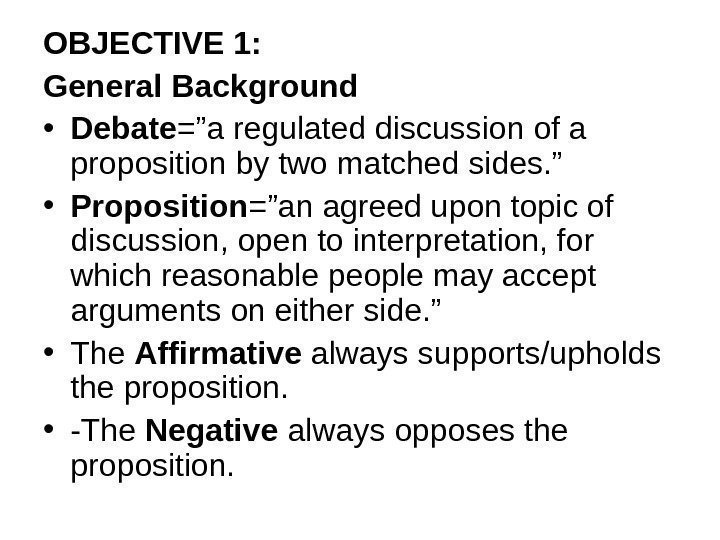
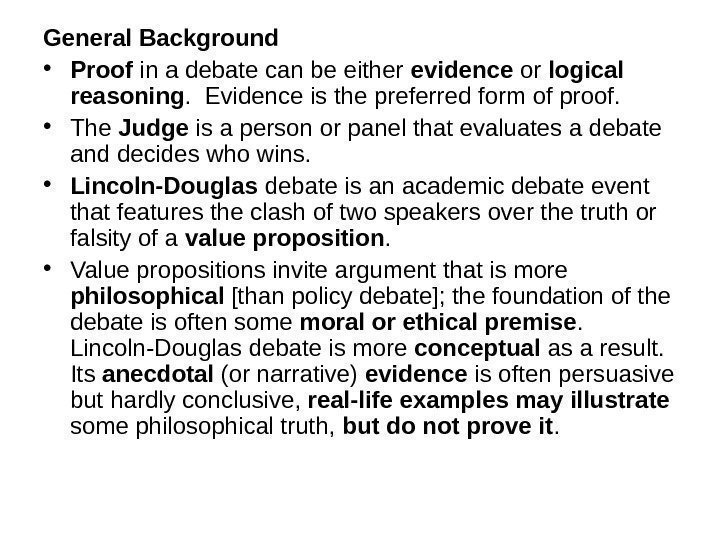
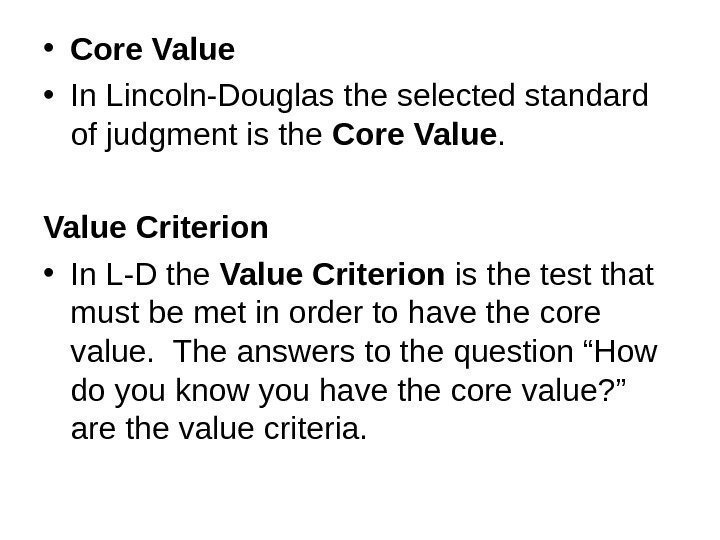

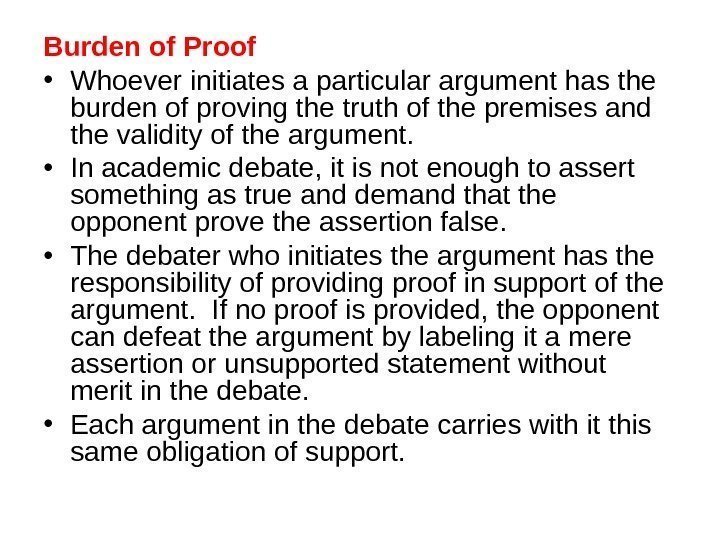

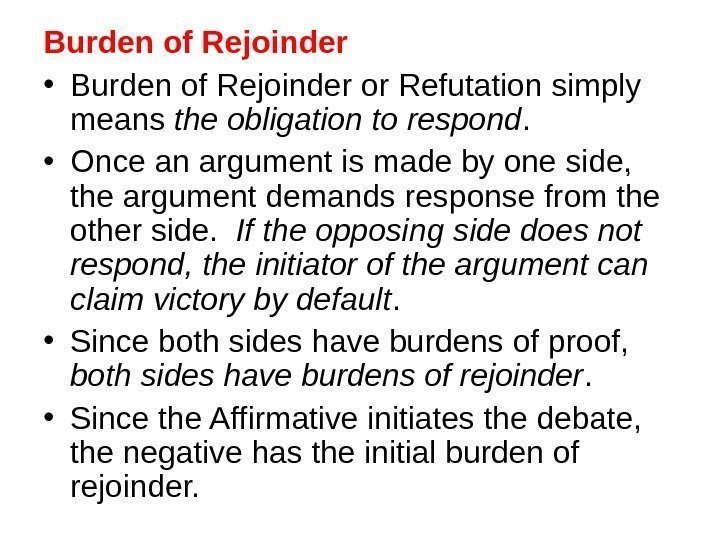
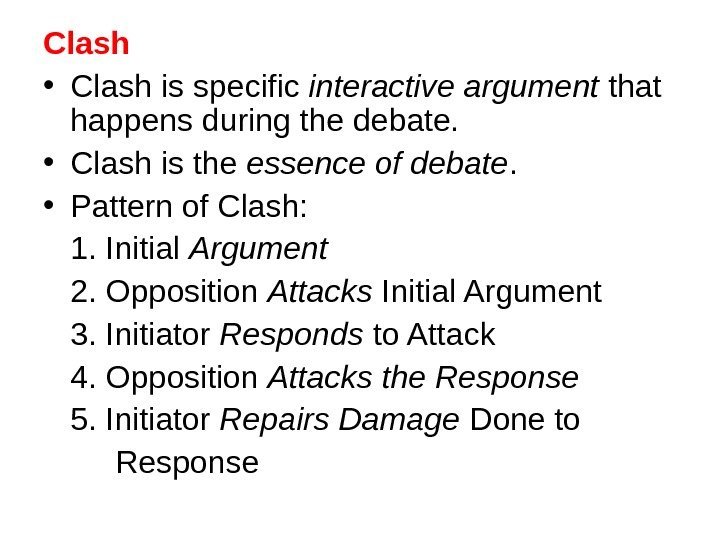
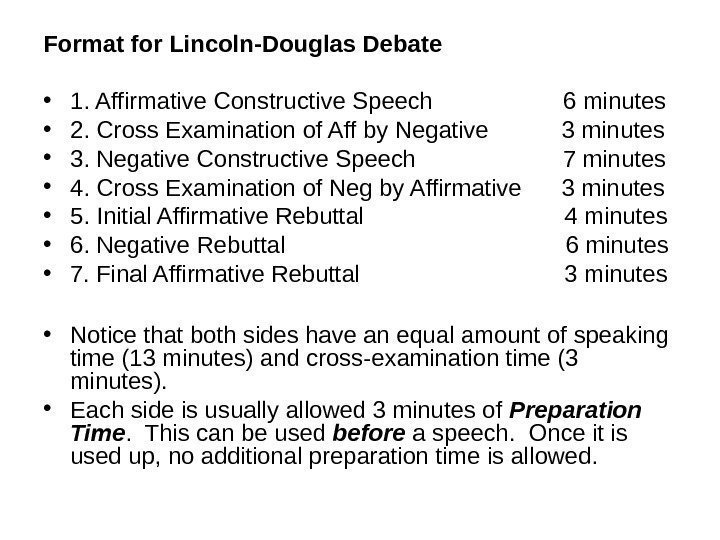
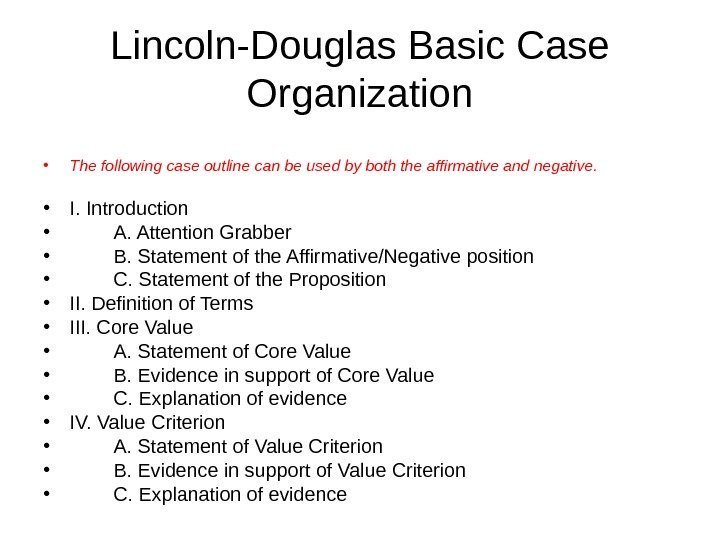
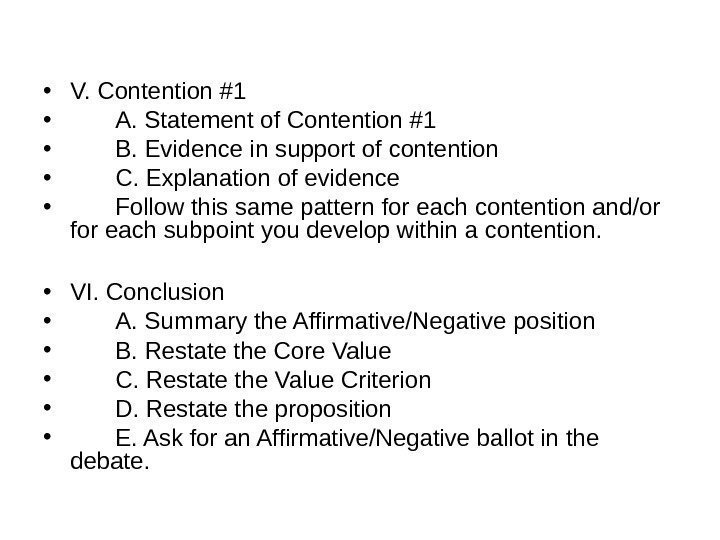

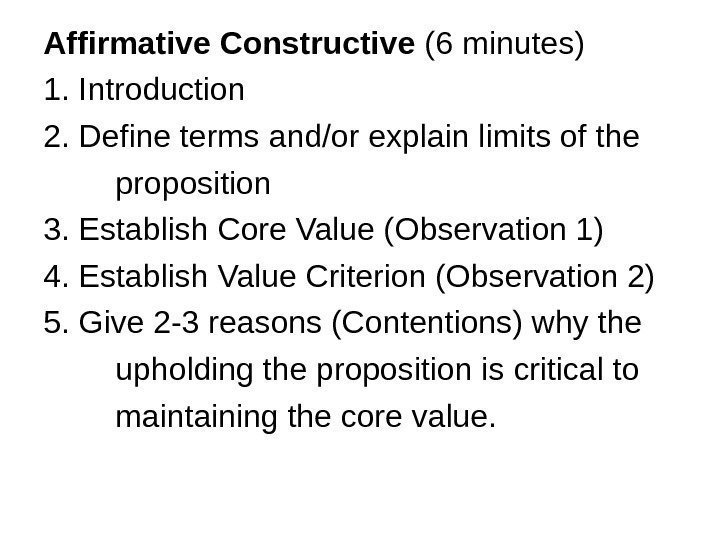
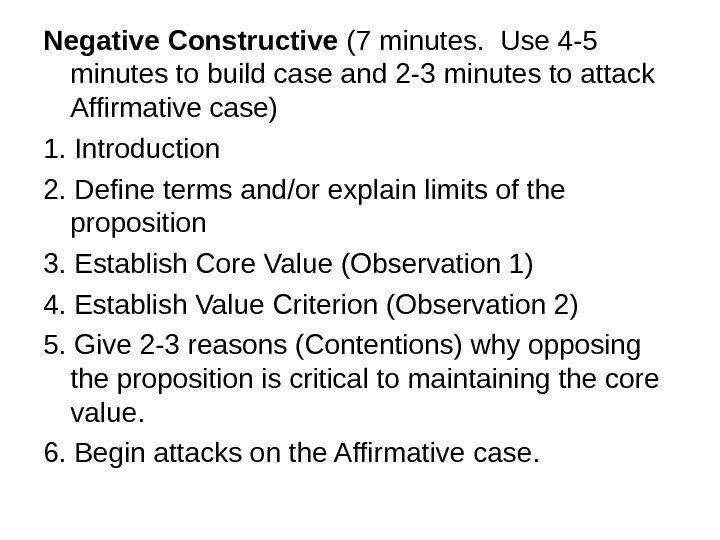
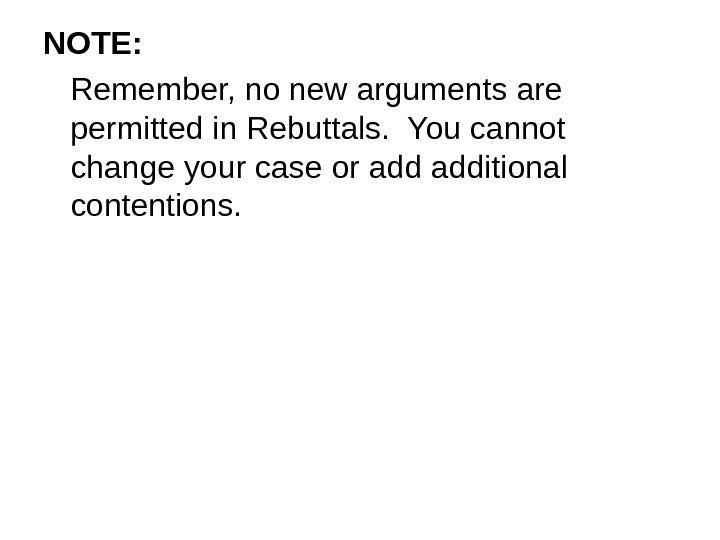
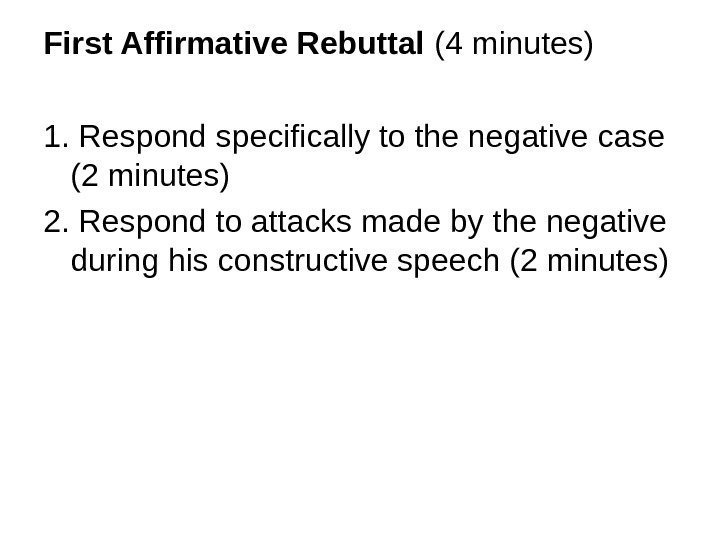

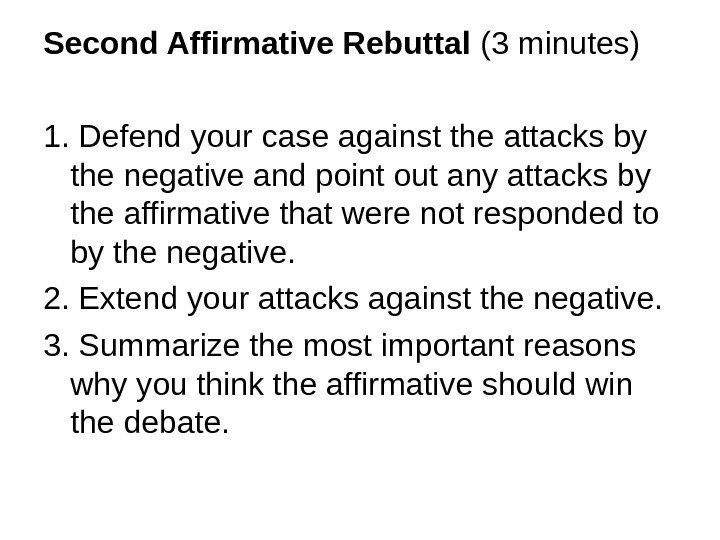
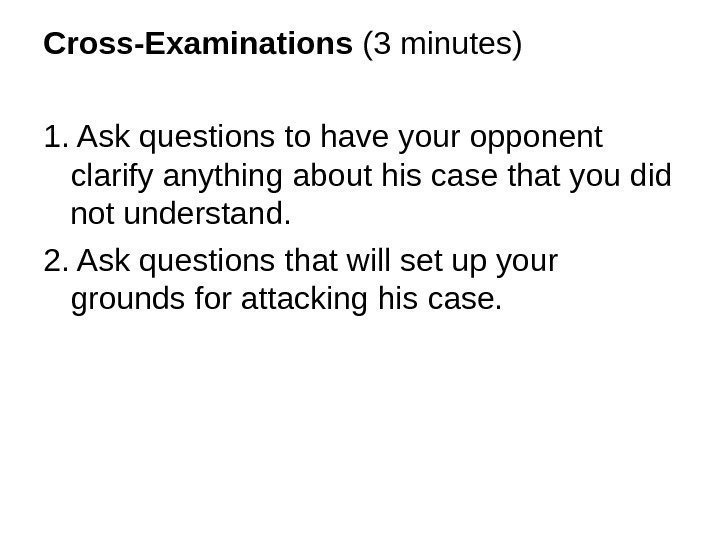
lincoln-douglas_debate.ppt
- Размер: 133.5 Кб
- Автор:
- Количество слайдов: 22
Описание презентации Lincoln-Douglas Debate An Examination of Values по слайдам
 Lincoln-Douglas Debate An Examination of Values
Lincoln-Douglas Debate An Examination of Values
 • OBJECTIVES: The student wil l • 1. Demonstrate understanding of the concepts that underlie Lincoln-Douglas Debate. • 2. Write at least one Lincoln-Douglas affirmative or negative case. • 3. Demonstrate understanding of the procedures used in Lincoln-Douglas Debate. • MEETING OBJECTIVE 1: Demonstrate understanding of the concepts that underlie Lincoln-Douglas Debate. The student will • A. Participate in class discussions of the following concepts: debate, affirmative, negative, proposition of fact, proposition of value, proposition of policy, core value, value criteria, burden of proof, refutation, clash, constructive speech, rebuttal speech, cross examination, contention, observation, Lincoln-Douglas debate format, flowing a debate. • B. Construct propositions of fact, value, and policy. • C. Take a written quiz about the concepts in “A” above. • D. Flow at least one Lincoln-Douglas debate. • MEETING OBJECTIVE 2: Write at least one Lincoln-Douglas affirmative or negative case. The student will • A. Conduct research on the current national Lincoln-Douglas debate topic. • B. Write either an affirmative or negative case for the current national Lincoln-Douglas debate topic. • MEETING OBJECTIVE 3: Demonstrate understanding of the procedures used in Lincoln-Douglas Debate. The student will • A. Participate in at least one Lincoln-Douglas debate. • B. Complete an evaluation form for at least one Lincoln-Douglas debate.
• OBJECTIVES: The student wil l • 1. Demonstrate understanding of the concepts that underlie Lincoln-Douglas Debate. • 2. Write at least one Lincoln-Douglas affirmative or negative case. • 3. Demonstrate understanding of the procedures used in Lincoln-Douglas Debate. • MEETING OBJECTIVE 1: Demonstrate understanding of the concepts that underlie Lincoln-Douglas Debate. The student will • A. Participate in class discussions of the following concepts: debate, affirmative, negative, proposition of fact, proposition of value, proposition of policy, core value, value criteria, burden of proof, refutation, clash, constructive speech, rebuttal speech, cross examination, contention, observation, Lincoln-Douglas debate format, flowing a debate. • B. Construct propositions of fact, value, and policy. • C. Take a written quiz about the concepts in “A” above. • D. Flow at least one Lincoln-Douglas debate. • MEETING OBJECTIVE 2: Write at least one Lincoln-Douglas affirmative or negative case. The student will • A. Conduct research on the current national Lincoln-Douglas debate topic. • B. Write either an affirmative or negative case for the current national Lincoln-Douglas debate topic. • MEETING OBJECTIVE 3: Demonstrate understanding of the procedures used in Lincoln-Douglas Debate. The student will • A. Participate in at least one Lincoln-Douglas debate. • B. Complete an evaluation form for at least one Lincoln-Douglas debate.
 • Key Terms and Concepts for Unit Two • debate refutation • Affirmative clash • Negative constructive speech • proposition of fact rebuttl speech • proposition of value cross examination • proposition of policy contention • core value observation • value criteria flowing a debate • burden of proof • Lincoln-Douglas debate format
• Key Terms and Concepts for Unit Two • debate refutation • Affirmative clash • Negative constructive speech • proposition of fact rebuttl speech • proposition of value cross examination • proposition of policy contention • core value observation • value criteria flowing a debate • burden of proof • Lincoln-Douglas debate format
 OBJECTIVE 1: General Background • Debate =”a regulated discussion of a proposition by two matched sides. ” • Proposition =”an agreed upon topic of discussion, open to interpretation, for which reasonable people may accept arguments on either side. ” • The Affirmative always supports/upholds the proposition. • -The Negative always opposes the proposition.
OBJECTIVE 1: General Background • Debate =”a regulated discussion of a proposition by two matched sides. ” • Proposition =”an agreed upon topic of discussion, open to interpretation, for which reasonable people may accept arguments on either side. ” • The Affirmative always supports/upholds the proposition. • -The Negative always opposes the proposition.
 General Background • Proof in a debate can be either evidence or logical reasoning. Evidence is the preferred form of proof. • The Judge is a person or panel that evaluates a debate and decides who wins. • Lincoln-Douglas debate is an academic debate event that features the clash of two speakers over the truth or falsity of a value proposition. • Value propositions invite argument that is more philosophical [than policy debate]; the foundation of the debate is often some moral or ethical premise. Lincoln-Douglas debate is more conceptual as a result. Its anecdotal (or narrative) evidence is often persuasive but hardly conclusive, real-life examples may illustrate some philosophical truth, but do not prove it.
General Background • Proof in a debate can be either evidence or logical reasoning. Evidence is the preferred form of proof. • The Judge is a person or panel that evaluates a debate and decides who wins. • Lincoln-Douglas debate is an academic debate event that features the clash of two speakers over the truth or falsity of a value proposition. • Value propositions invite argument that is more philosophical [than policy debate]; the foundation of the debate is often some moral or ethical premise. Lincoln-Douglas debate is more conceptual as a result. Its anecdotal (or narrative) evidence is often persuasive but hardly conclusive, real-life examples may illustrate some philosophical truth, but do not prove it.
 • Core Value • In Lincoln-Douglas the selected standard of judgment is the Core Value Criterion • In L-D the Value Criterion is the test that must be met in order to have the core value. The answers to the question “How do you know you have the core value? ” are the value criteria.
• Core Value • In Lincoln-Douglas the selected standard of judgment is the Core Value Criterion • In L-D the Value Criterion is the test that must be met in order to have the core value. The answers to the question “How do you know you have the core value? ” are the value criteria.
 2 types of value propositions: 1. Propositions that make some declaration of value or importance about a single entity. Example: Laws which protect citizens form themselves are justified. 2. Judgments of comparison between two entities. Example: An oppressive government is more desirable than no government at all.
2 types of value propositions: 1. Propositions that make some declaration of value or importance about a single entity. Example: Laws which protect citizens form themselves are justified. 2. Judgments of comparison between two entities. Example: An oppressive government is more desirable than no government at all.
 Burden of Proof • Whoever initiates a particular argument has the burden of proving the truth of the premises and the validity of the argument. • In academic debate, it is not enough to assert something as true and demand that the opponent prove the assertion false. • The debater who initiates the argument has the responsibility of providing proof in support of the argument. If no proof is provided, the opponent can defeat the argument by labeling it a mere assertion or unsupported statement without merit in the debate. • Each argument in the debate carries with it this same obligation of support.
Burden of Proof • Whoever initiates a particular argument has the burden of proving the truth of the premises and the validity of the argument. • In academic debate, it is not enough to assert something as true and demand that the opponent prove the assertion false. • The debater who initiates the argument has the responsibility of providing proof in support of the argument. If no proof is provided, the opponent can defeat the argument by labeling it a mere assertion or unsupported statement without merit in the debate. • Each argument in the debate carries with it this same obligation of support.
 Burden of Proof • In L-D the Affirmative’s job is to argue that the proposition is reasonable for anyone to believe. • The Affirmative has the burden of proving the reasonableness of the proposition. • The Negative has the burden of proving the proposition false or unreasonable. • In other words, both sides share the burden of proof equally. Neither side is assumed to be true at the beginning of the debate. • The Affirmative or the Negative may claim that the opponent has not met his burden of proof, but that alone will not win the debate. The side making the claim must have met its burden of proof. In other words, you don’t win just because the other side did not do its job; you must meet your burden of proof to win.
Burden of Proof • In L-D the Affirmative’s job is to argue that the proposition is reasonable for anyone to believe. • The Affirmative has the burden of proving the reasonableness of the proposition. • The Negative has the burden of proving the proposition false or unreasonable. • In other words, both sides share the burden of proof equally. Neither side is assumed to be true at the beginning of the debate. • The Affirmative or the Negative may claim that the opponent has not met his burden of proof, but that alone will not win the debate. The side making the claim must have met its burden of proof. In other words, you don’t win just because the other side did not do its job; you must meet your burden of proof to win.
 Burden of Rejoinder • Burden of Rejoinder or Refutation simply means the obligation to respond. • Once an argument is made by one side, the argument demands response from the other side. If the opposing side does not respond, the initiator of the argument can claim victory by default. • Since both sides have burdens of proof, both sides have burdens of rejoinder. • Since the Affirmative initiates the debate, the negative has the initial burden of rejoinder.
Burden of Rejoinder • Burden of Rejoinder or Refutation simply means the obligation to respond. • Once an argument is made by one side, the argument demands response from the other side. If the opposing side does not respond, the initiator of the argument can claim victory by default. • Since both sides have burdens of proof, both sides have burdens of rejoinder. • Since the Affirmative initiates the debate, the negative has the initial burden of rejoinder.
 Clash • Clash is specific interactive argument that happens during the debate. • Clash is the essence of debate. • Pattern of Clash: 1. Initial Argument 2. Opposition Attacks Initial Argument 3. Initiator Responds to Attack 4. Opposition Attacks the Response 5. Initiator Repairs Damage Done to Response
Clash • Clash is specific interactive argument that happens during the debate. • Clash is the essence of debate. • Pattern of Clash: 1. Initial Argument 2. Opposition Attacks Initial Argument 3. Initiator Responds to Attack 4. Opposition Attacks the Response 5. Initiator Repairs Damage Done to Response
 Format for Lincoln-Douglas Debate • 1. Affirmative Constructive Speech 6 minutes • 2. Cross Examination of Aff by Negative 3 minutes • 3. Negative Constructive Speech 7 minutes • 4. Cross Examination of Neg by Affirmative 3 minutes • 5. Initial Affirmative Rebuttal 4 minutes • 6. Negative Rebuttal 6 minutes • 7. Final Affirmative Rebuttal 3 minutes • Notice that both sides have an equal amount of speaking time (13 minutes) and cross-examination time (3 minutes). • Each side is usually allowed 3 minutes of Preparation Time. This can be used before a speech. Once it is used up, no additional preparation time is allowed.
Format for Lincoln-Douglas Debate • 1. Affirmative Constructive Speech 6 minutes • 2. Cross Examination of Aff by Negative 3 minutes • 3. Negative Constructive Speech 7 minutes • 4. Cross Examination of Neg by Affirmative 3 minutes • 5. Initial Affirmative Rebuttal 4 minutes • 6. Negative Rebuttal 6 minutes • 7. Final Affirmative Rebuttal 3 minutes • Notice that both sides have an equal amount of speaking time (13 minutes) and cross-examination time (3 minutes). • Each side is usually allowed 3 minutes of Preparation Time. This can be used before a speech. Once it is used up, no additional preparation time is allowed.
 Lincoln-Douglas Basic Case Organization • The following case outline can be used by both the affirmative and negative. • I. Introduction • A. Attention Grabber • B. Statement of the Affirmative/Negative position • C. Statement of the Proposition • II. Definition of Terms • III. Core Value • A. Statement of Core Value • B. Evidence in support of Core Value • C. Explanation of evidence • IV. Value Criterion • A. Statement of Value Criterion • B. Evidence in support of Value Criterion • C. Explanation of evidence
Lincoln-Douglas Basic Case Organization • The following case outline can be used by both the affirmative and negative. • I. Introduction • A. Attention Grabber • B. Statement of the Affirmative/Negative position • C. Statement of the Proposition • II. Definition of Terms • III. Core Value • A. Statement of Core Value • B. Evidence in support of Core Value • C. Explanation of evidence • IV. Value Criterion • A. Statement of Value Criterion • B. Evidence in support of Value Criterion • C. Explanation of evidence
 • V. Contention #1 • A. Statement of Contention #1 • B. Evidence in support of contention • C. Explanation of evidence • Follow this same pattern for each contention and/or for each subpoint you develop within a contention. • VI. Conclusion • A. Summary the Affirmative/Negative position • B. Restate the Core Value • C. Restate the Value Criterion • D. Restate the proposition • E. Ask for an Affirmative/Negative ballot in the debate.
• V. Contention #1 • A. Statement of Contention #1 • B. Evidence in support of contention • C. Explanation of evidence • Follow this same pattern for each contention and/or for each subpoint you develop within a contention. • VI. Conclusion • A. Summary the Affirmative/Negative position • B. Restate the Core Value • C. Restate the Value Criterion • D. Restate the proposition • E. Ask for an Affirmative/Negative ballot in the debate.
 Speaker Duties • Constructive Speeches are those speeches during which debaters present those arguments upon which they hope to win the debate. • Any argument is considered legitimate to present during a constructive speech. • The purpose of Rebuttals is to attack the opponent’s case or to defend your case from the opponent’s attacks. No new arguments may be presented during rebuttals, but additional evidence may be presented in support of initial arguments.
Speaker Duties • Constructive Speeches are those speeches during which debaters present those arguments upon which they hope to win the debate. • Any argument is considered legitimate to present during a constructive speech. • The purpose of Rebuttals is to attack the opponent’s case or to defend your case from the opponent’s attacks. No new arguments may be presented during rebuttals, but additional evidence may be presented in support of initial arguments.
 Affirmative Constructive (6 minutes) 1. Introduction 2. Define terms and/or explain limits of the proposition 3. Establish Core Value (Observation 1) 4. Establish Value Criterion (Observation 2) 5. Give 2 -3 reasons (Contentions) why the upholding the proposition is critical to maintaining the core value.
Affirmative Constructive (6 minutes) 1. Introduction 2. Define terms and/or explain limits of the proposition 3. Establish Core Value (Observation 1) 4. Establish Value Criterion (Observation 2) 5. Give 2 -3 reasons (Contentions) why the upholding the proposition is critical to maintaining the core value.
 Negative Constructive (7 minutes. Use 4 -5 minutes to build case and 2 -3 minutes to attack Affirmative case) 1. Introduction 2. Define terms and/or explain limits of the proposition 3. Establish Core Value (Observation 1) 4. Establish Value Criterion (Observation 2) 5. Give 2 -3 reasons (Contentions) why opposing the proposition is critical to maintaining the core value. 6. Begin attacks on the Affirmative case.
Negative Constructive (7 minutes. Use 4 -5 minutes to build case and 2 -3 minutes to attack Affirmative case) 1. Introduction 2. Define terms and/or explain limits of the proposition 3. Establish Core Value (Observation 1) 4. Establish Value Criterion (Observation 2) 5. Give 2 -3 reasons (Contentions) why opposing the proposition is critical to maintaining the core value. 6. Begin attacks on the Affirmative case.
 NOTE: Remember, no new arguments are permitted in Rebuttals. You cannot change your case or additional contentions.
NOTE: Remember, no new arguments are permitted in Rebuttals. You cannot change your case or additional contentions.
 First Affirmative Rebuttal (4 minutes) 1. Respond specifically to the negative case (2 minutes) 2. Respond to attacks made by the negative during his constructive speech (2 minutes)
First Affirmative Rebuttal (4 minutes) 1. Respond specifically to the negative case (2 minutes) 2. Respond to attacks made by the negative during his constructive speech (2 minutes)
 Negative Rebuttal (6 minutes) 1. Defend your case against the affirmative’s attacks from affirmative rebuttal 2. Extend your attacks against the affirmative, and point out any attacks by you that the affirmative did not answer. 3. Summarize the most important reasons why you think the negative should win the debate.
Negative Rebuttal (6 minutes) 1. Defend your case against the affirmative’s attacks from affirmative rebuttal 2. Extend your attacks against the affirmative, and point out any attacks by you that the affirmative did not answer. 3. Summarize the most important reasons why you think the negative should win the debate.
 Second Affirmative Rebuttal (3 minutes) 1. Defend your case against the attacks by the negative and point out any attacks by the affirmative that were not responded to by the negative. 2. Extend your attacks against the negative. 3. Summarize the most important reasons why you think the affirmative should win the debate.
Second Affirmative Rebuttal (3 minutes) 1. Defend your case against the attacks by the negative and point out any attacks by the affirmative that were not responded to by the negative. 2. Extend your attacks against the negative. 3. Summarize the most important reasons why you think the affirmative should win the debate.
 Cross-Examinations (3 minutes) 1. Ask questions to have your opponent clarify anything about his case that you did not understand. 2. Ask questions that will set up your grounds for attacking his case.
Cross-Examinations (3 minutes) 1. Ask questions to have your opponent clarify anything about his case that you did not understand. 2. Ask questions that will set up your grounds for attacking his case.

